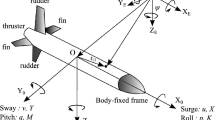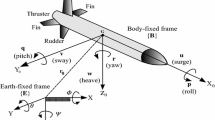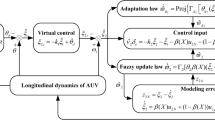Abstract
This paper addresses an adaptive fuzzy exponential terminal sliding mode trajectory tracking control design for autonomous underwater vehicle (AUV) using time delay estimation. The proposed control scheme assures quick convergence due to a nonlinear expression in to an integral augmented sliding surface results in nonlinear sliding mode termed as integral-fast terminal sliding mode control (IFTSMC). Furthermore, control law requires no prior knowledge about highly nonlinear underwater vehicle model due to the time delay estimation method. Meanwhile, fuzzy logic system incorporated as adaptation mechanism afford for varying switching function and adaptive exponential reaching law utilized for faster reaching time in path tracking control performance. Finally, the effectiveness and robustness of the proposed control strategy are demonstrated through numerical simulations with Cyclops AUV in presence of parameter perturbations and unidentified disturbances like ocean current, wave and measurement noise.










Similar content being viewed by others
References
Arimoto S, Miyazaki F (1984) Stability and robustness of PID feedback control for robot manipulators of sensor capability. In: Brady M, Paul R (eds) Robot research. MIT Press, Cambridge, pp 783–799
Yoerger D, Slotine J (1985) Robust trajectory control of underwater vehicles. IEEE J Oceanic Eng 10(4):462–470
Goheen KR, Jefferys ER (1990) Multivariable self-turning autopilots for autonomous underwater vehicles. IEEE J Oceanic Eng 15(3):144–151
Triantafyllou MS, Grosenbaugh MA (1991) Robust control for underwater vehicle systems with time delays. IEEE J Oceanic Eng 16(1):146–151
Nakamura Y, Savant S (1992) Nonlinear tracking control of autonomous underwater vehicles. In: Proceedings of IEEE international conference on robotics and automation, vol 3, pp 44–49
Antonelli G, Chiaverini S, Sarkar N, West M (2001) Adaptive control of an autonomous underwater vehicle: experimental results on ODIN. IEEE Trans Control Syst Technol 9(5):756–765
Silvestre C, Pascoal A, Kaminer I (2002) On the design of gain scheduled trajectory tracking controllers. Int J Robust Nonlinear Control 12:797–839
Pisano A, Usai E (2004) Output-feedback control of an underwater vehicle prototype by higher-order sliding modes. Automatica 40:1525–1531
Feng Z, Allen R (2004) Reduced order \(H^{\infty }\) control of an autonomous underwater vehicle. Control Eng Pract 13:1511–1520
Yuh J (1990) A neural net controller for underwater robotic vehicles. IEEE J Oceanic Eng 15(3):161–166
DeBitetto PA (1995) Fuzzy logic for depth control of unmanned undersea vehicles. IEEE J Oceanic Eng 20(3):242–248
Londhe PS, Santhakumar M, Patre BM, Waghmare LM (2017) Task space control of an autonomous underwater vehicle manipulator system by robust single-input fuzzy logic control scheme. IEEE J Oceanic Eng 42(1):13–28
Moura A, Rijo R, Silva P, Crespo S (2010) A multi-objective genetic algorithm applied to autonomous underwater underwater vehicles for sewage outfall plume dispersion observations. Appl Soft Comput 10(4):1119–1126
Wang JS, Lee CSG (2003) Self-adaptive recurrent neuro-fuzzy control of an autonomous underwater vehicle. IEEE Trans Robot Autom 19(2):283–295
Cristi R, Papoulias FA, Healey AJ (1990) Adaptive sliding mode control of autonomous underwater vehicles in the dive plane. IEEE J Oceanic Eng 15(3):152–160
Fossen TI, Sagatun S (1991) Adaptive control of nonlinear systems: a case study of underwater robotic systems. J Robotic Syst 8(3):393–412
Healey AJ, Lienard D (1993) Multivariable sliding mode control for autonomous diving and steering of unmanned underwater vehicles. IEEE J Oceanic Eng 18(3):327–339
Soylu S, Buckham BJ, Podhorodeski RP (2008) A chattering-free sliding-mode controller for underwater vehicles with fault tolerant infinity-norm thrust allocation. Ocean Eng 35:1647–1659
Zhou HY, Liu KZ, Feng XS (2011) State feedback sliding mode control without chattering by constructing Hurwitz matrix for AUV movement. Int J Autom Comput 8(2):262–268
Kim M, Joe H, Kim J, Yu SC (2015) Integral sliding mode controller for precise manoeuvring of autonomous underwater vehicle in the presence of unknown environmental disturbances. Int J Control 26(2):1–11
Wang Y, Gu L, Gao M, Zhu K (2015) Multivariable output feedback adaptive terminal sliding mode control for underwater vehicles. Asian J Control 17(6):1–19
Xu J, Wang M, Qiao L (2015) Dynamical sliding mode control for the trajectory tracking of underactuated unmanned underwater vehicles. Ocean Eng 105:54–63
Santhakumar M, Asokan T (2010) Investigations on the hybrid tracking control of an underactuated autonomous underwater robot. Adv Robot 24:1529–1556
Zhu D, Sun B (2013) The bio-inspired model based hybrid sliding-mode tracking control for unmanned underwater vehicles. Eng Appl Artif Intell 26:2260–2269
Bartolini G, Pisano A (2010) Black-box position and attitude tracking for underwater vehicles by second-order sliding-mode technique. Int J Robust Nonlinear Control 20(2):1594–1609
Ismail ZH, Putranti VWE (2015) Second order sliding mode control scheme for an autonomous underwater vehicle with dynamic region concept. Math Probl Eng 20:1–13
Lee PM, Hong SW, Lim YK, Lee CM, Jeon BH, Park JW (1999) Discrete-time quasi-sliding mode control of an autonomous underwater vehicle. IEEE J Oceanic Eng 24(3):388–395
Prasanth Kumar R, Dasgupta A, Kumar CS (2007) Robust trajectory control of underwater vehicles using time delay control law. Ocean Eng 34:842–849
Kim J, Joe H, Yu SC, Lee JS, Kim M (2015) Time delay controller design for position control of autonomous underwater vehicle under disturbances. IEEE Trans Industr Electron 63(2):1052–1061
Fossen TI (1994) Guidance and control of ocean vehicles. Wiley, New York, pp 448–451
Feng Y, Yu X, Man Z (2002) Non-singular terminal sliding mode control of rigid manipulators. Automatica 38(12):21592167
Chen W, Wei Y, Zeng J, Han H, Jia X (2015) Adaptive terminal sliding mode NDO-based control of underactuated AUV in vertical plane. Discret Dyn Nat Soc 21:1–9
Elmokadem T, Zribi M, Toumi KY (2015) Trajectory tracking sliding mode control of underactuated AUVs. Nonlinear Dyn 24:22–35
Author information
Authors and Affiliations
Corresponding author
Rights and permissions
About this article
Cite this article
Lakhekar, G.V., Waghmare, L.M. Adaptive fuzzy exponential terminal sliding mode controller design for nonlinear trajectory tracking control of autonomous underwater vehicle. Int. J. Dynam. Control 6, 1690–1705 (2018). https://doi.org/10.1007/s40435-017-0387-6
Received:
Revised:
Accepted:
Published:
Issue Date:
DOI: https://doi.org/10.1007/s40435-017-0387-6




